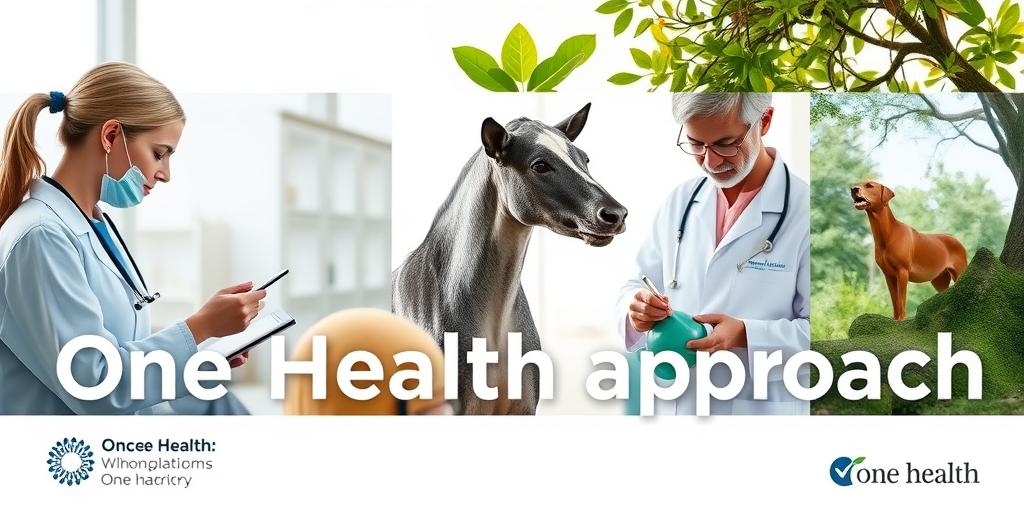The One Health Approach: An Interconnected Future for Human, Animal, and Environmental Well-being
In an increasingly interconnected world, the health of humans, animals, and the environment are inextricably linked. Recognizing this interdependence, the One Health approach has emerged as a collaborative, multidisciplinary strategy to address complex health challenges. This article explores the core principles of One Health, its applications, and its growing importance in safeguarding global well-being.
Understanding the One Health Concept
One Health is not a new concept, but rather a formalized framework that acknowledges the interconnectedness of various life domains. It promotes collaborative efforts across diverse fields, including:
- Human health: Physicians, nurses, public health professionals
- Animal health: Veterinarians, livestock specialists, wildlife experts
- Environmental health: Ecologists, environmental scientists, conservationists
The goal is to achieve optimal health outcomes by recognizing the relationships between people, animals, plants, and their shared environment.
Key Principles of One Health
The One Health approach is guided by several core principles:
- Interdisciplinarity: Encouraging collaboration and communication among various disciplines.
- Integration: Combining knowledge and expertise to develop comprehensive solutions.
- Collaboration: Fostering partnerships between government agencies, research institutions, and community stakeholders.
- Prevention: Focusing on proactive measures to reduce health risks.
- Sustainability: Ensuring long-term solutions that protect the health of current and future generations.
Applications of the One Health Approach
The One Health approach has broad applications across various sectors:
- Infectious Disease Control: Addressing zoonotic diseases (diseases transmissible from animals to humans) such as rabies, influenza, and COVID-19 through coordinated surveillance, prevention, and control measures.
- Antimicrobial Resistance: Combating the rise of antibiotic-resistant bacteria by promoting responsible antibiotic use in human and animal medicine, as well as in agriculture.
- Food Safety and Security: Ensuring a safe and sustainable food supply by addressing foodborne illnesses, promoting animal welfare, and reducing the environmental impact of agriculture.
- Environmental Health: Protecting ecosystems and biodiversity to prevent the emergence and spread of diseases, as well as mitigating the health impacts of climate change and pollution.
- Chronic Diseases: Understanding the role of environmental factors and animal interactions in the development of chronic diseases such as obesity, diabetes, and cancer.
Examples of One Health in Action
Several successful One Health initiatives demonstrate the effectiveness of this approach:
- Global Rabies Control: Coordinated vaccination campaigns in animal populations to prevent human rabies cases.
- Antimicrobial Stewardship Programs: Implementing guidelines for responsible antibiotic use in hospitals and veterinary clinics.
- Wildlife Disease Surveillance: Monitoring wildlife populations for emerging diseases that could potentially spill over to humans.
- Environmental Monitoring: Assessing water and air quality to identify and mitigate environmental health risks.
The Future of One Health
As the world faces increasingly complex health challenges, the One Health approach will play a crucial role in safeguarding global well-being. Key priorities for the future include:
- Strengthening collaboration and communication among different sectors.
- Investing in research to better understand the links between human, animal, and environmental health.
- Developing innovative tools and technologies for disease surveillance and prevention.
- Building capacity in low- and middle-income countries to implement One Health initiatives.
- Promoting public awareness and engagement in One Health issues.
Conclusion
The One Health approach offers a holistic and integrated framework for addressing the complex health challenges of the 21st century. By recognizing the interconnectedness of human, animal, and environmental health, we can develop more effective and sustainable solutions to protect the well-being of all. Embracing the One Health approach is essential for creating a healthier and more sustainable future for generations to come.
